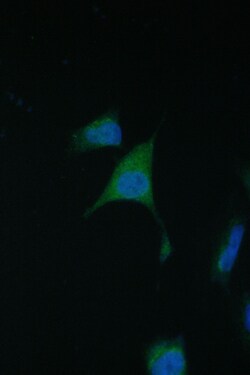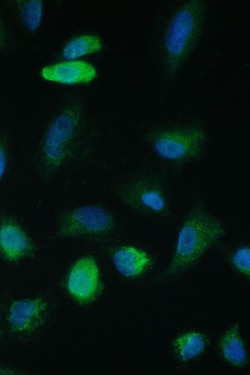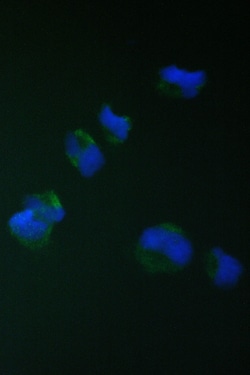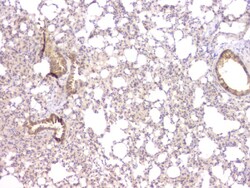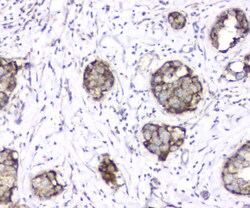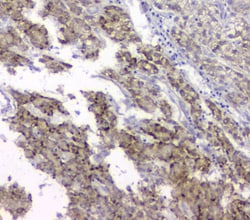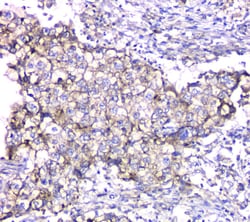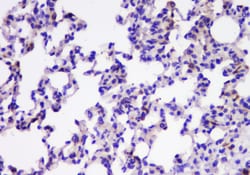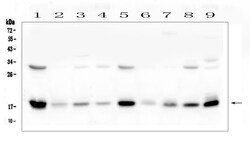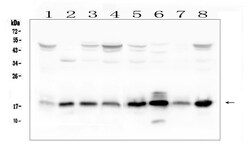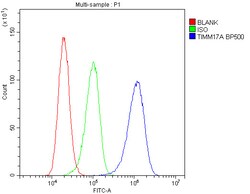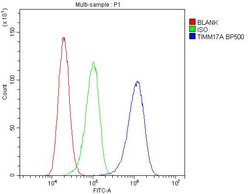Learn More
Invitrogen™ TIM17 Polyclonal Antibody
Rabbit Polyclonal Antibody
Supplier: Invitrogen™ PA595635
Description
Reconstitute with 0.2 mL of distilled water to yield a concentration of 500 μg/mL. Positive Control - WB: rat heart tissue, rat lung tissue, rat liver tissue, rat brain tissue, mouse heart tissue, mouse lung tissue, mouse liver tissue, mouse brain tissue, mouse Neuro-2a whole cell, human placenta tissue, human K562 whole cell, human T-47D whole cell, human Caco-2 whole cell, human Hela whole cell, human THP-1 whole cell, human A431 whole cell, human A549 whole cell. IHC: human liver cancer tissue, human lung cancer tissue, human mammary cancer tissue, rat lung tissue, mouse lung tissue. ICC/IF: HELA cell, A549 cell, A549 cell. Flow: A431 cell. Store at -20°C for one year from date of receipt. After reconstitution, at 4°C for one month. It can also be aliquotted and stored frozen at -20°C for six months. Avoid repeated freeze-thaw cycles.
Translocation of nuclear encoded preproteins into the mitochondrial matrix requires the coordinated action of the translocases Tom and Tim, which are located in the outer mitochondrial membrane and the inner membrane, respectively. The mitochondrial preprotein translocases of the outer membrane (Tom) is a multi-subunit protein that contains at least eight proteins: four import receptor subunits (Tom70, Tom37, Tom22, and Tom20), three small proteins (Tom7, Tom6, and Tom5), and a structural component of the outer membrane channel (Tom40). The Tom machinery involves the import receptors, which initiate the binding of cytosolically synthesized preproteins to the outer membrane, and a general import pore (GIP), which promotes the translocation of various pre-proteins into the mitochondria. The TIM channel imports nuclear-encoded mitochondrial preproteins, and it involves three proteins, Tim17, Tim23 and Tim44, which are represented at equimolar ratios. Tim17 is expressed as two isoforms Tim17a and Tim17b, which differ only in their C termini sequences, and like Tim23, these proteins are ubiquitously expressed in fetal and adult tissues. Tim17 and Tim23 are integral membrane proteins that comprise the structural elements of the inner membrane channel by which the preproteins are transferred. The Tim44, on the other hand, is a largely hydrophilic protein that recruits the matrix located Hsp70 to the site where the preprotein emerges from the Tim channel.
Specifications
| TIM17 | |
| Polyclonal | |
| Unconjugated | |
| TIMM17A | |
| 17kDa; fb82c12; Inner membrane preprotein translocase Tim17a; Mimt17; Mitochondrial import inner membrane translocase subunit Tim17-A; Mitochondrial import inner membrane translocase subunit Tim17-A-like protein; mitochondrial inner membrane translocase; mTim17a; preprotein translocase; Tim17; TIM17A; TIMM17; TIMM17A; timm17a protein; translocase of inner mitochondrial membrane 17 homolog A; translocase of inner mitochondrial membrane 17 homolog A (yeast); translocase of inner mitochondrial membrane 17a; translocator of inner mitochondrial membrane 17 kDa, a; translocator of inner mitochondrial membrane 17a; translocator of inner mitochondrial membrane a; wu:fb82c12 | |
| Rabbit | |
| Affinity chromatography | |
| RUO | |
| 10440, 21854, 54311 | |
| -20°C | |
| Lyophilized |
| Flow Cytometry, Immunohistochemistry (Frozen), Immunohistochemistry (Paraffin), Western Blot, Immunocytochemistry | |
| 500 μg/mL | |
| PBS with 4 mg trehalose and 0.05 mg sodium azide | |
| O35092, Q99595, Q9Z0V8 | |
| TIMM17A | |
| A synthetic peptide corresponding to a sequence of human TIMM17A (LFSMIDCSMVQVRGKED). | |
| 100 μg | |
| Primary | |
| Human, Mouse, Rat | |
| Antibody | |
| IgG |
Your input is important to us. Please complete this form to provide feedback related to the content on this product.
